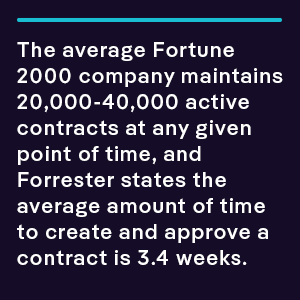Prestigious Annual Awards Program Recognizes Innovative Companies, Products, and Services Supporting the Legal Field

ContractPodAi has been selected as winner of the “Best Use of AI in LegalTech” award in the third annual LegalTech Breakthrough Awards program conducted by LegalTech Breakthrough, a leading independent market intelligence organization that evaluates and recognizes standout legal technology companies, products and services around the globe.
The mission of the annual LegalTech Breakthrough Awards program is to conduct the industry’s most comprehensive analysis and evaluation of the top technology companies, solutions and products in the legal technology industry today. This year’s program attracted more than 1,450 nominations from over 12 different countries throughout the world.
ContractPodAi has been recognized on behalf of its Contract Risk and Compliance (CR&C) feature, which uses AI to assist in contract reviews – including a pre-built Contract Compliance Program to help companies get started while also delivering users a visualized risk profile.
“The entire team at ContractPodAi is thrilled to accept this award from LegalTech Breakthrough. Our goal is to push the boundaries of what’s possible in legal tech, helping in-house legal teams to be ready for anything. By leveraging the analytic power of AI, we can help to automate and streamline contract review, and proactively manage risk,” said Sarvath Misra, co-founder and CEO of ContractPodAi. “CR&C accelerates the process in which contracts and the businesses can move forward, while giving users the confidence that they’ve caught everything and they’re seeing up to date views of the risk levels of the contract. Our customers have reported their contract review going from a couple hours or more, to 20-30 minutes, thanks to the power of our AI review.”
Leveraging AI for Contract Risk & Compliance
The legal industry has been slow to digitize processes, and the pain of this is felt during contract negotiations and management. To put this into perspective, the average Fortune 2000 company maintains 20,000-40,000 active contracts at any given point of time, and Forrester states the average amount of time to create and approve a contract is 3.4 weeks.
“Highly trained legal professionals are spending hours on manual work. The industry is in need of technology to accelerate the rate at which contracts are created and approved, while keeping compliance top of mind,” said Bryan Vaughn, Managing Director of LegalTech Breakthrough Awards. “CR&C brings legal teams a layer of support for reviewing and managing risk. This feature uses advanced technologies such as AI, natural language processing, and deep learning to assist with the traditionally time-consuming task of reviewing and approving contracts. Congratulations on winning the incredibly future-forward ‘Best Use of AI in LegalTech’ award.”
CR&C automates contract review, including third-party paper, by analyzing and extracting key legal obligations. Users receive a visual risk scorecard as the AI has completed its review. This scorecard helps legal focus on risk without having to review the entire contract, as the risk scorecards highlight risk and the non-compliant clauses.
Once the AI runs and surfaces non-compliant clauses, users can take corrective action right from the application. From the Preview Document, users can view the company playbook which has compliant text, guidance and fallback language for the specific contract and clause. Or they can edit the clause, mark “Compliant”, accept risk and then re-run the AI for an updated risk profile.
CR&C also provides a library of pre-built buy-side, sell-side and corporate playbooks that can be customized. These playbooks eliminate the complexity and time-consuming work of building playbooks from scratch. General Counsel can control contract compliance at all levels with digital playbooks as well as set permissions around who can take corrective actions. These playbooks also empower junior resources to do first-level review and, once completed, it automatically delivers to senior leaders for signature.
Download our datasheet here to learn more about the benefits of AI-powered Contract Risk and Compliance.
####
About ContractPodAi
Well-established as a leader in end-to-end contract lifecycle management, ContractPodAi harnesses AI for leading corporations around the world. Now, the platform’s robust, intuitive, and easy-to-use capabilities have been extended to handle the entire legal lifecycle – any use-case, any document type, any scenario. ContractPodAi’s ‘One Legal Platform’ is designed to help in-house counsel initiate, automate, execute, and manage any legal scenario.
ContractPodAi Cloud amplifies your business’s readiness through our partnerships with complementary technology providers including IBM, Microsoft, DocuSign, and Salesforce. ContractPodAi® is headquartered in London and has global offices in New York, Glasgow, Chicago, Sydney, Mumbai, and Toronto.
Learn more about ContractPodAi at: https://contractpodai.com
About LegalTech Breakthrough
Part of Tech Breakthrough, a leading market intelligence and recognition platform for global technology innovation and leadership, the LegalTech Breakthrough Awards program is devoted to honoring excellence in legal technologies, services, companies and products. The LegalTech Breakthrough Awards program provides a forum for public recognition around the achievements of LegalTech companies and solutions in categories including Case Management, Client Relations, Data and Analytics, Documentation, Legal Education, Practice Management, eDiscovery and more. For more information visit LegalTechBreakthrough.com



